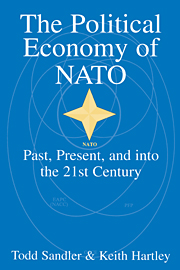Book contents
- Frontmatter
- Contents
- List of tables and figures
- Preface
- 1 NATO at the crossroads: An introduction
- 2 NATO burden sharing and related issues
- 3 On NATO expansion
- 4 NATO and peacekeeping
- 5 NATO and the defense industrial base: EU and USA
- 6 NATO challenges on the horizon
- 7 NATO and Europe
- 8 NATO design
- 9 Conclusions and future scenarios
- References
- Author index
- Subject index
5 - NATO and the defense industrial base: EU and USA
Published online by Cambridge University Press: 05 June 2012
- Frontmatter
- Contents
- List of tables and figures
- Preface
- 1 NATO at the crossroads: An introduction
- 2 NATO burden sharing and related issues
- 3 On NATO expansion
- 4 NATO and peacekeeping
- 5 NATO and the defense industrial base: EU and USA
- 6 NATO challenges on the horizon
- 7 NATO and Europe
- 8 NATO design
- 9 Conclusions and future scenarios
- References
- Author index
- Subject index
Summary
NATO's defense industries are adjusting to the disarmament following the end of the Cold War. Industrial adjustment has been reflected in job losses, plant closures, a search for new military and civil markets at home and overseas (e.g., arms exports and diversification), national and international mergers, and strategic alliances. By 1998, industrial restructuring had been most evident in the US, where a series of major mergers had created three giant defense companies – Boeing, Lockheed-Martin, and Raytheon. In Europe in late 1996 there was a major initiative towards joint procurement with the formation of a quadrilateral armaments agency comprising France, Germany, Italy, and the United Kingdom, known as OCCAR. This agency aims to achieve a more efficient, effective approach to the management of collaborative defense programs. By 1998, the major European nations had announced plans to restructure their aerospace and defense electronics industries.
There are few authoritative economic studies on the size, structure, conduct, and performance of NATO's defense industries. What is known, what is not known, and what is it necessary to know for an informed debate and sensible public choices concerning NATO's defense industries? The performance of these industries is important in an era of expensive equipment, rising weapons costs, and disarmament. The efficiency with which equipment is supplied is an important determinant of national and alliance defense output, so that member states cannot avoid questioning the efficiency and competitiveness of their national defense industries and their market arrangements for the procurement of weapons.
- Type
- Chapter
- Information
- The Political Economy of NATOPast, Present and into the 21st Century, pp. 119 - 164Publisher: Cambridge University PressPrint publication year: 1999



